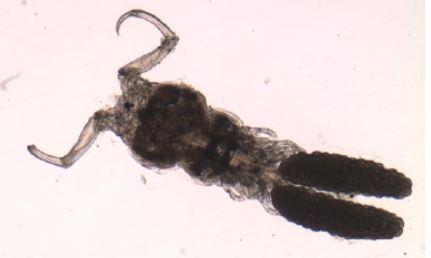The organism possesses an oblong cephalothorax, with the first pedigerous somite not incorporated into it. There is an inverse T-shaped marking on the dorsal surface of the cephalic shield. The mandible consists of anterior, middle, and posterior blades. The maxillule is lobate and adorned with setae, a middle process, and spinules, while the maxilla has rows of sharp teeth anteriorly. The second to fourth pedigerous somites are free and narrow posteriorly. It has six-segmented antennules and four-segmented antennae.
The swimming legs from the first to the fourth have three-segmented rami, except for the fourth leg, which has a two-segmented exopod. The fifth leg is two-segmented. The genital double-somite is wider than it is long and features ornamentation with five rows of ventral spinules. The first free abdominal somite is slightly longer than the second one, and the anal somite is deeply incised and smaller than the second abdominal somite. Each posterior margin of the abdominal somites is ornamented with rows of spinules.
The caudal rami are quite long, extending beyond the anal somite. The egg sacs are long and cylindrical in shape, and the color of the organism is described as creamy white.
